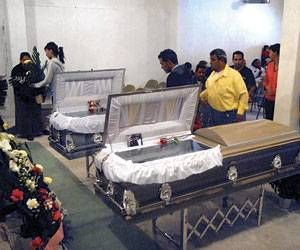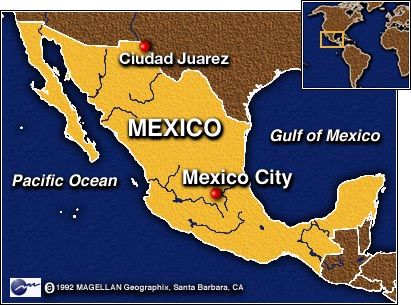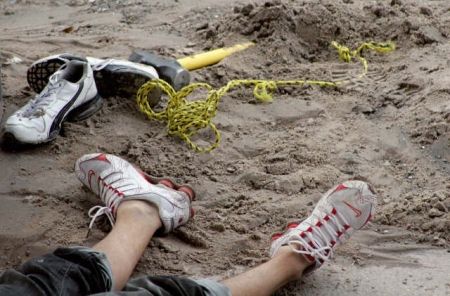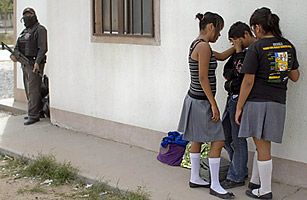
Publisher:
Bonnie King
CONTACT:
Newsroom@Salem-news.com
Advertising:
Adsales@Salem-news.com

~Truth~
~Justice~
~Peace~
TJP
Mar-03-2011 04:36

 TweetFollow @OregonNews
TweetFollow @OregonNews
The Slaughter of Children
Salem-News.comThe homicide rate in Ciudad Juarez and the state of Chihuahua in 2009 was nearly seven times greater than the Mexican national average for minors.
 Courtesy: cem.com.mx |
(CIUDAD, JUAREZ, Mexico) - In Ciudad Juarez and other parts of Mexico, the killings of children and young people are now routine headlines. In particular, the last week has been a rough time for many families in the border city.
Wednesday, a half-dozen young people between the ages of 8 to 16 were sprayed with bullets while playing in the Granjas de Chapultepec neighborhood.
Sisters Briseida and Karen Barraza Carrasco, aged 15 and 14, respectively, were slain together their 12-year-old friend Esmeralda Lozoya Enriquez. A student at Technical Middle School Number 79,
Esmeralda dreamed of becoming a criminologist, according to mother Maria del Rosario Enriquez.
"They were innocent girls who wanted to live life," Enriquez said of Esmeralda and her friends.
"They wanted to know, to experiment, to talk about boyfriends... they were beginning to live."
In Mexico City, the National Human Rights Commission asked law enforcement authorities to provide protection to the affected families and open an investigation with the "seriousness this case merits and detain the responsible parties."
 |
In a separate incident, 15-year-old Adrian Jovani Armendariz also was murdered on February 23. Described as a high grade-earner who attended the CBITIS 128 high school, Armendariz was a member of the Jaguars American football team. The Jaguars' trainer described Armendariz as a "strong" young man who was an "indispensable" member of the team. The young athlete was the son of a local transit cop who was murdered last year. Armendariz's school is no stranger to violence: four CBITIS 128 students were among the victims of last year's massacre in the Villas de Salvarcar neighborhood.
In a Chihuahua City presentation late last month, State Human Rights Commission (CEDH) investigator Gustavo de la Rosa said 10 "zones of extermination" had been identified in Ciudad Juarez. According to de la Rosa, 200 families have been victimized in the areas in question since 2009.
The slaughter of children in Ciudad Juarez continued into this week. On Monday, February 28, an unidentified 10-year old was reported among four people murdered while in a car at a busy intersection. An adolescent survivor and a younger child were wounded and transferred to Mexican Social Security Institute Hospital Number 35, where gunmen soon stormed the premises in an unsuccessful attempt to finish off the injured teenager. Gunshots, however, were fired and other patients and hospital staff thrown into panic.

On Wednesday, March 2, a 15-year-old girl who was not immediately identified was gunned down in the Toribio Ortega section of the city.
The issue of "youthcide" is grabbing increased attention at both the national and international levels. After the Granjas de Chapultepec slayings were reported, the non-governmental Network for the Rights of Children in Mexico (REDIM) demanded that federal and state authorities thoroughly investigate the atrocity.
The youth advocacy organization likewise exhorted the Mexican government to comply with February 4 recommendations made by the United Nations Committee on the Rights of the Child for the Mexican government to compile data on the number of children detained, injured or killed in the so-called narco war.
According to REDIM, Ciudad Juarez and the state of Chihuahua experienced the killings of 75 children per 100,000 inhabitants in 2009; the homicide rate was nearly seven times greater than the Mexican national average for minors. Chihuahua is the only state that doesn't have a specific law dedicated to the rights of children, REDIM noted.
The network earlier estimated that about 1,000 children had been slain in incidents related to organized crime from December 2006 to December 2010: during the first 55 days of 2011, at least 52 children and adolescents were killed across Mexico in similar episodes, according to REDIM.
 Boy's body in Ciudad Juarez. Photo: Tucson Sentinel from 13 July 2010 |
Young people aged 18 to 29 make up another important rung of the murder victim registry in Ciudad Juarez and Mexico. Two years ago, 20-year-old Ciudad Juarez resident Juan Antonio Chavez Morales was studying at the Autonomous University of Ciudad Juarez (UACJ) to become a paramedic.
According to mother Maria del Carmen Morales, her son enjoyed swimming and mountain biking. Then in December 2009, in the presence of friends, Chavez was dragged from a nightclub by a group of men.
He was swiftly executed five blocks from the scene of the abduction in Ciudad Juarez's Pronaf district.
"The police haven't investigated," Morales contended in an interview with Frontera NorteSur.
In April 2010, Morales filed a complaint against law enforcement authorities with the CEDH.
To cope with the tragedy, Morales said her family accepted therapeutic help from the UACJ. The bereaved mother also reached out to relatives of other violent crime victims, networking and sharing the anguish of personal loss.
"The pain and impunity that exists unites us," Morales said. Survivors of murder, she added, have become part of a "fraternity."
 |
In early 2010, Morales joined a group of relatives of murdered and disappeared young people that traveled from Ciudad Juarez to Mexico City to testify in the lower house of the Mexican Congress.
One year later, Morales and others are still waiting for justice.
"Now I'm not only blaming the state government, but also the national one," Morales told Frontera NorteSur.
"Nobody is interested."
The Ciudad Juarez mother recalled a visit last year by Mexican First Lady Margarita Zavala to the Villas de Salvarcar neighborhood, scene of the mass killing of 16 young people and adults in January 2010. But Morales questioned why Zavala limited her excursion to Villas de Salvarcar.
"It is not out of envy for the people there," she said, "but if you gather together all the people who are in mourning like us, you would have to fill a stadium."
Additional sources:
- Lapolaka.com, March 2, 2011.
- El Universal, March 1, 2011.
- El Diario de Juarez, February 28, 2011.
- El Diario de El Paso, February 28, 2011. Article by Ramon Chaparro.
- Norte, February 26, 2011. Article by Herika Martinez Prado.
- Cimacnoticias, February 25, 2011.
- National Human Rights Commission, February 24, 2011.
- Press release. La Jornada, February 24, 2011.
Frontera NorteSur is made possible by reader contributions and a grant from the McCune Charitable Foundation
Frontera NorteSur: on-line, U.S.-Mexico border news
Center for Latin American and Border Studies
New Mexico State University
Las Cruces, New Mexico
Articles for March 2, 2011 | Articles for March 3, 2011 | Articles for March 4, 2011

googlec507860f6901db00.html
Salem-News.com:
Quick Links
DINING
Willamette UniversityGoudy Commons Cafe
Dine on the Queen
Willamette Queen Sternwheeler
MUST SEE SALEM
Oregon Capitol ToursCapitol History Gateway
Willamette River Ride
Willamette Queen Sternwheeler
Historic Home Tours:
Deepwood Museum
The Bush House
Gaiety Hollow Garden
AUCTIONS - APPRAISALS
Auction Masters & AppraisalsCONSTRUCTION SERVICES
Roofing and ContractingSheridan, Ore.
ONLINE SHOPPING
Special Occasion DressesAdvertise with Salem-News
Contact:AdSales@Salem-News.com


Terms of Service | Privacy Policy
All comments and messages are approved by people and self promotional links or unacceptable comments are denied.
TexMex77 March 3, 2011 5:12 pm (Pacific time)
The lowlifes committing these atrocities do not have too much time before they become useless to their puppet masters. Then they become part of the estimates... Get some pride - create don't destroy you bunch of lazy sob's.
[Return to Top]©2026 Salem-News.com. All opinions expressed in this article are those of the author and do not necessarily reflect those of Salem-News.com.